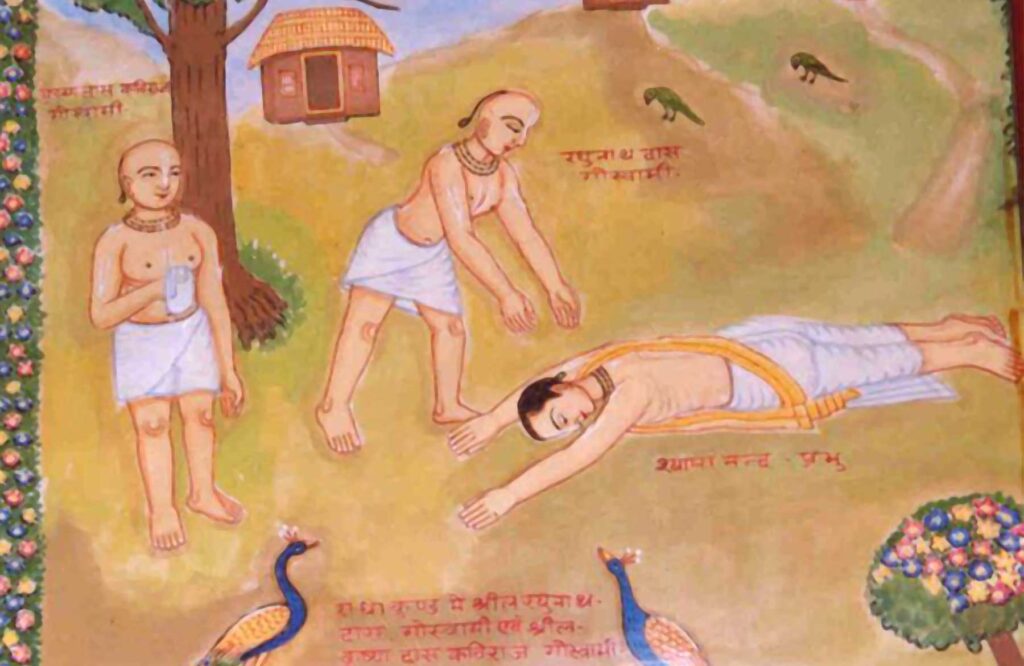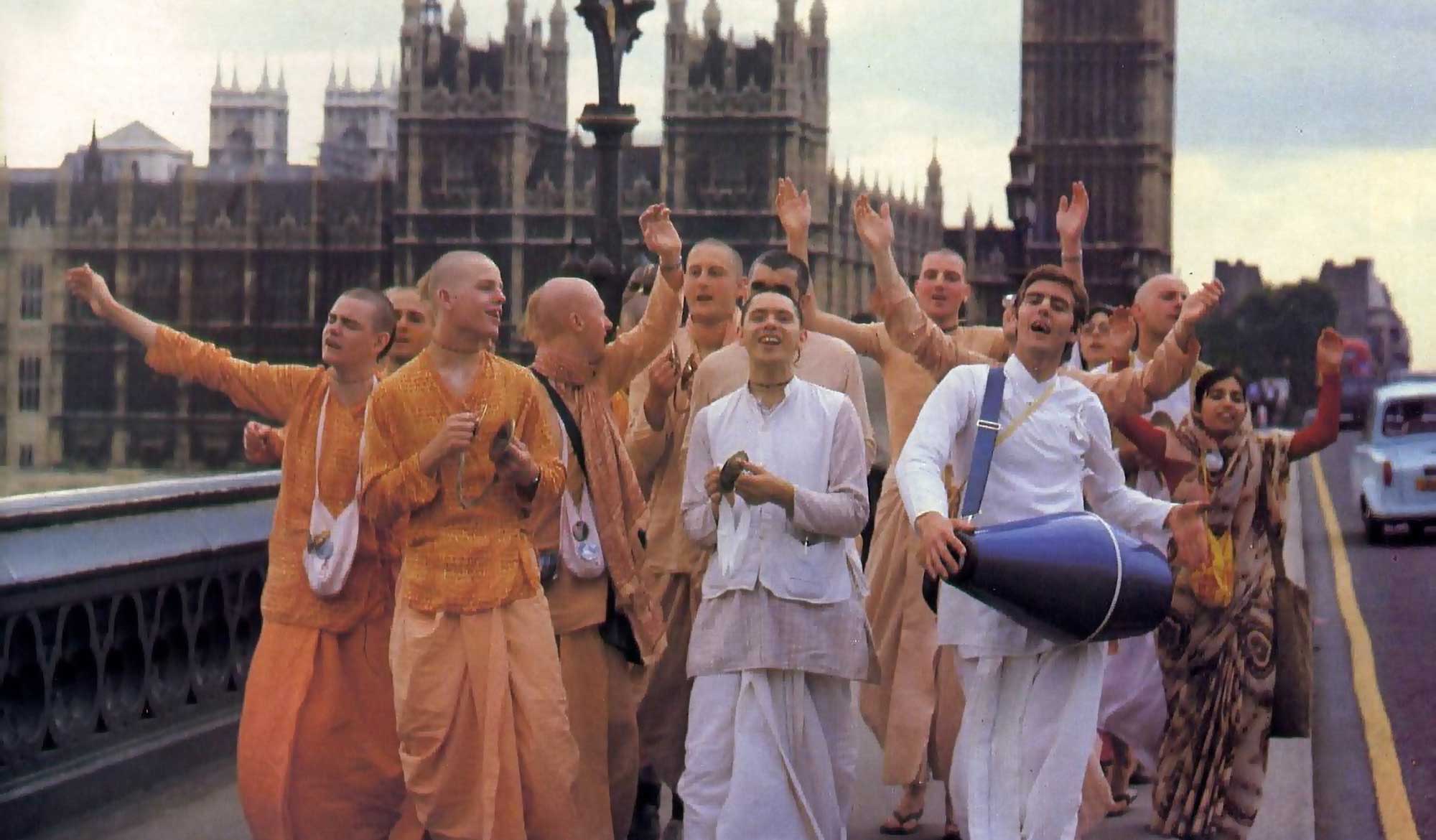Overview
This article Śrī Śrīman Mahāprabhura Sambandhe Vitarka (A Dispute about Śrī Śrī Mahāprabhu) was first published Sajjana Toṣaṇī Vol 4, Issue 1 in 1892 and deals with the doubts created by certain caste-gosvāmīs on the validity of the gaura-mantra, and the necessity of fasting on the appearance day of Śrī Caitanya Mahāprabhu.
(translated by Swami B.V. Giri and Sanātana Dāsa)
Four years have passed since I was performing bhajana in a lonely cave after a pause in preaching work. Recently, on the request of certain Vaiṣṇavas, I visited a certain locality and I became upset regarding certain issues. I heard that some of the descendants of an ācārya have concluded that Śrī Śrīman Mahāprabhu is not worshipped by separate mantras and on His appearance day there is no need to perform any austerity accompanied by fasting.
Before judging whether the ācāryas descendants are qualified to come to such conclusions, I wanted to mention something – why has this question been raised whether Mahāprabhu has His own mantra or not? Did this particular descendent of the ācārya present this issue with a simple heart, or was he enthused by some other intention other than that of pure transcendental subject matter? Did the debate manifest from the motivation of removing some fault within the Gauḍīya Vaiṣṇava sampradāya? After analysing this for some time, I came to the conclusion that it did not.
If he had such a motivation, he would surely have tried to rectify the appropriate faults that existed. Dear Devotees! There have been many faults that have arisen within the Gauḍīya sampradāya during the last four hundred years. To eradicate those faults and unwanted elements completely is the primary responsibility of the descendants of the ācāryas. What is the meaning of the word ‘ācārya? Only one who acts in order to teach others about dharma is an ācārya. Simply by creating controversy in order to improve the condition of one’s family does not make one eligible to occupy the position of an ācārya. Those who have gained the position of an ācārya in the Gauḍīya sampradāya should try to eradicate the faults that existing within the sampradāya. I will now mention a few of those faults.
Nowadays, the Vaiṣṇavas of the Gauḍīya sampradāya can be divided into four divisions, namely:
1) Respected ācāryas that give initiation into the mantra (mantra-ācāryas)
2) Vaiṣṇavas who are invited and subsist on the basis of collecting alms.
3) Those situated in varṇāśrama who have gained expertise in reciting the Bhāgavata
4) People identified as Vaiṣṇavas by caste (jāti-vaiṣṇavas).
Among these four divisions of Vaiṣṇavas, those who behave against the principles of bhakti are the root cause of the faults existing within the sampradāya.
I will not speak inimically against any particular person, so if my words are against anyone’s conduct, then I ask his kind forgiveness. With a good heart and good intention, I will try to discuss the primary faults existing in the aforementioned four divisions of devotees.
Respected initiating ācāryas are expected to be exemplary as per the śāstras and should initiate suitable candidates into the mantra. Regarding this, although there is mention of mutual examination from both sides in Śrī Hari-bhakti-vilāsa, it is not applied in real life. When the relationship between the guru and disciple is made without proper consideration of mutual qualification, then this creates a poor precedent and leads to further degradation within the sampradāya. Where there is no consideration of proper qualification or eligibility, everything goes in vain. Alas! How the pure Vaiṣṇava religion preached by Śrī Śrī Mahāprabhu has been polluted!
Vaiṣṇavas who subsist on collecting alms have also deviated from proper consideration of eligibility that has led to various unwanted faults manifesting in the sampradāya. Before one takes shelter of subsisting on alms, one must be qualified for this particular āśrama. Nowadays such considerations are no longer observed.
Since there is a dire scarcity of proper understanding of devotional conclusions amongst Vaiṣṇavas situated within varṇāśrama, they have become devoid of discriminating between the honest and the crooked; they associate with anyone and everyone and show undue respect without proper consideration, leading to the pollution of their mind. To purify the mind, the living entity has to take shelter of pure devotion–yet this is not happening and the result is a deficiency of saintly association.
Nowadays due to the negligence of the mantra-ācāryas, there has almost been a complete deprivation of pure devotional conclusions amongst the Vaiṣṇavas. The caste-gosvāmīs, despite being deprived of pure devotion, demand to be honoured as Vaiṣṇavas and such demands have also been honoured by those Vaiṣṇavas situated in varṇāśrama who lack the proper faculty of discrimination.
I have just given a glimpse of the above faults. If necessary I will surely analyse all of them in detail on a case-by-case basis. To eliminate all these faults, it is essential to organize a conference of the above-mentioned four divisions of Vaiṣṇavas and organize a meeting to rectify the faults found within the sampradāya. With gratefulness, I would like to humbly request that venerable mantra-ācāryas initiate such a meeting to take careful steps in rectifying the above-mentioned faults. Among the mantra-ācāryas, those who have unique devotion to Śrī Gaurāṅga will naturally be inclined to keep their lineage free of deceit. The unfortunate thing is that instead of taking adequate steps to rectify the faults within the sampradāya, vain disputes are raised about Śrīman Mahāprabhu which I fail to understand.
If there is no dispute about the fact that Śrīman Mahāprabhu is Himself the Supreme Lord, the son of Nanda, then in regards to Him, there is bound to be inevitable differences between regulated worship (vaidhi-bhakti) and spontaneous worship (rāgānuga-bhakti). Is there a necessity to raise such a controversy before one follows these steps? The devotees on the path of rāgānuga-bhakti have not adhered, nor will ever adhere to the rules and regulations prescribed by those ācāryas in vaidhi-bhakti. Śrī Kavirāja Gosvāmī has said:
śāstra yukti nahi mane rāgānugara prakṛti
Those of the path of spontaneous devotion do not care for the injunctions of the scriptures of logical arguments. (Cc. Madhya 22.153)
If the organiser on the path of vaidhi-bhakti attempts to make arrangements for the path of rāgānuga, he will be like a potter trying to make curd – such arrangements will never be successful. Just as it is unfair for those devotees on the path of rāgānuga to criticize the injunctions followed by devotees of the path of vaidhi, similarly it is not appropriate for mantra-ācāryas that follow vaidhi-bhakti to try to create regulations for the devotees on the path of rāgānuga. This only results in dissension without any fruitful result.
I would humbly suggest that nobody should try to destroy the separate paths of worship that are already followed for the regulative and spontaneous worship of Śrīman Mahāprabhu. I will be more than happy if I am not required to speak further on this topic.













